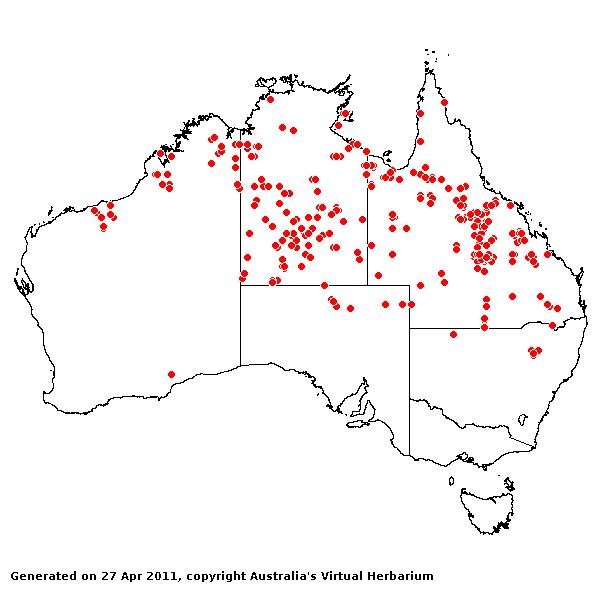Eragrostis speciosa (Roem. &
Schult.) Steud. Syn. Pl. Glum. 1: 279 (1854).
Classification. (GPWG 2001) : Subfamily Chloridoideae. Cynodonteae.
Basionym and/or
Replacement Name: Poa speciosa
Roem. & Schult., Syst. Veg. 2: 573 (1817).
Type of Basionym or
Protologue Information: LT: R. Brown 6273, 1802–1805, Australia:
"inter australiense".
Recent synonyms:
E. oldfieldii.
Key references
(books and floras): [1878] G.Bentham, Flora Australiensis 7 (648),
[1952] C.A.Gardner, Flora of Western Australia 1 Gramineae (119
& as E. oldfieldii), [1981] M.Lazarides in J.Jessop (ed)., Flora
of Central Australia (458), [2002] D.Sharp & B.K.Simon, AusGrass,
Grasses of Australia, [2006] J.Jessop, G.R.M.Dashorst, F.M.James, Grasses
of South Australia (381), [2008] S.W.L.Jacobs, R.D.B.Walley &
D.J.B.Wheeler, Grasses of New South Wales (257).
Illustrations:
[1952] C.A.Gardner, Flora of Western Australia 1 Gramineae (120,
Pl. 34), [2005] K.Mallet (ed.), Flora of Australia 44B: Poaceae 3
(Fig. 65J-K), [2006] J.Jessop, G.R.M.Dashorst, F.M.James, Grasses of South
Australia (381, fig. 314), [2008]
S.W.L.Jacobs, R.D.B.Whalley & D.J.B.Wheeler, Grasses of New South Wales,
4th edn (257).
Habit.
Perennial. Culms erect, stature slender to delicate, 15–140 cm tall. Ligule a
fringe of hairs, 0.3–0.6 mm long. Leaf-blades straight, flat or involute or
convolute, 15–25 cm long, 1–2 mm wide. Leaf-blade surface glabrous.
Inflorescence.
Inflorescence compound, a panicle or a panicle. Panicle linear or oblong, 7–47
cm long, 1.2–2.5 cm wide.
Spikelets.
Spikelets sessile or pedicelled. Fertile spikelets many flowered, with at least
2 fertile florets (10–110(-145)), comprising 10–110(–145) fertile floret(s),
with diminished florets at the apex, linear or lanceolate, laterally
compressed, 4.5–50 mm long.
Glumes. Glumes
similar. Lower glume lanceolate, membranous, keeled, 1-keeled, 1 -nerved. Upper
glume lanceolate, 1.2–1.8 mm long, membranous, keeled, 1-keeled, 1 -nerved.
Florets.
Fertile lemma 1.5–2 mm long, keeled, 3 -nerved. Lemma apex muticous. Lodicules
present. Anthers 2. Grain 0.5 mm long.
Continental
Distribution: Australasia.
Australian
Distribution: Western Australia, Northern Territory, South Australia,
Queensland, New South Wales.
Western Australia: Gardner, Dampier.
Fortescue, Austin. Northern Territory: Darwin & Gulf, Victoria River,
Barkly Tableland, Central Australia North, Central
Australia South. South Australia:
Lake Eyre. Queensland: Burke, Cook, Gregory
North, Leichhardt, Maranoa, Mitchell, North Kennedy, South Kennedy, Warrego,
Gregory South. New South Wales:
North-Western Plains.
Notes.
Distinguishing characters include relatively short, blunt palea with emarginate
apex, short keels and narrow flaps; anthers two; glumes partly scaberulous;
leaden spikelets with numerous closely imbricate florets and straight rachilla;
slender flaccid panicle; plant mostly glabrous and smooth, highly coloured,
with mealy scabrous filiform blades and ciliate ligule.
Endemic;
distribution is from northern and central Australia from around the Dampier
Penin. and Port Hedland in W.A. across to about Mackay on the E coast of Qld. S
to Wee Waa in northern N.S.W. Commonly in seasonally wet habitats (beds,
frontages and levees of watercourses, floodouts, seepage slopes, margins of
swamps and springs) with sandy alluvial soils; also in lateritic, calcareous
and saline soils and moist disturbed ground.; flowers all year round but not recorded
for Nov.; fruits all year round but not recorded for Nov.







